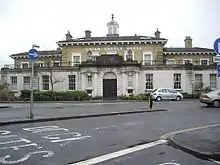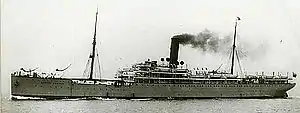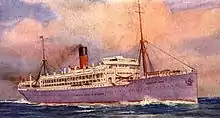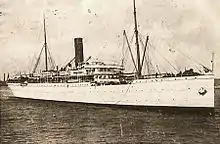Union-Castle Line
The Union-Castle Line was a British shipping line that operated a fleet of passenger liners and cargo ships between Europe and Africa from 1900 to 1977. It was formed from the merger of the Union Line and Castle Shipping Line.
 | |
 Union-Castle liners in East India Docks, London in 1902 | |
| Union-Castle Line | |
| Industry | Shipping |
| Predecessors |
|
| Founded | 8 March 1900 in United Kingdom |
| Defunct | 1990 |
| Successor | British and Commonwealth Shipping |
| Headquarters | United Kingdom |
Area served | London and Southampton to Cape Town |
Key people |
|
| Services | Passenger, cargo and mail transport |

It merged with Bullard King and Clan Line in 1956 to form British & Commonwealth Shipping, and then with South African Marine Corporation (commonly referred to as Safmarine) in 1973 to create International Liner Services, but maintained its separate identity throughout. Its shipping operations ceased in 1977.
Predecessor lines
.jpg.webp)

The Union Line was founded in 1853 as the Southampton Steam Shipping Company to transport coal from South Wales to Southampton. It was renamed the Union Steam Collier Company and then the Union Steamship Company. In 1857, renamed the Union Line, it won a contract to carry mail to South Africa, mainly the Cape Colony. The inaugural sailing of the Dane left Southampton on 15 September.[1]
Meanwhile, Donald Currie had built up the Castle Packet Co. which traded to Calcutta round the Cape of Good Hope. This trade was substantially curtailed by the opening of the Suez Canal in 1869, and the Castle Line started to run to South Africa instead, later becoming the Castle Mail Packet Company.
In 1872 the Cape Colony gained responsible government and its first Prime Minister, John Molteno, ordered a re-negotiation of the country's mail services. In 1876, keen to avoid either of the two main companies gaining a monopoly on the country's shipping, he awarded the South African mail contract jointly to both the Castle Mail Packet Company and the Union Line. The contract included a condition that the two companies would not amalgamate, as well as other clauses to promote competition, such as alternating services and speed premiums. This competition led to their shipping services running at unprecedented speed and efficiency. The contract was eventually to expire however, and the period of intense competition was later to give way to co-operation, including transporting troops and military equipment during the Boer War. Finally, on 8 March 1900, the Union Line and Castle Shipping Line merged, creating the Union-Castle Mail Steamship Company, Ltd, with Castle Shipping Line taking over the fleet.[2][3][4]
Union-Castle Line



.jpg.webp)



.jpg.webp)
.jpg.webp)
Union-Castle named most of their ships with the suffix "Castle" in their names; the names of several inherited from the Union Line were changed to this scheme (for example, Galician became Glenart Castle) but others (such as Galeka) retained their original name. They were well known for the lavender-hulled liners with red funnels topped in black, running on a rigid timetable between Southampton and Cape Town. Every Thursday at 4pm a Union-Castle Royal Mail Ship would leave Southampton bound for Cape Town. At the same time, a Union-Castle Royal Mail Ship would leave Cape Town bound for Southampton. In 1922 the line introduced its Round Africa service, a nine-week voyage calling at twenty ports en route. Alternate sailings travelled out via the Suez Canal and out via West Africa.[1]
The combined line was sold to the Royal Mail Line in 1911, but continued to operate as Union-Castle. Many of the line's vessels were requisitioned for service as troop ships or hospital ships in the First World War, and eight were sunk by mines or German U-boats. The Royal Mail Line ran into financial difficulties in the 1930s, culminating in the prosecution of its director Lord Kylsant, and Union-Castle Line became an independent company again with Vernon Thomson as Managing Director. Many vessels were again requisitioned in the Second World War. Three – Dunnottar Castle, Carnarvon Castle, Dunvegan Castle became armed merchant cruisers. Pretoria Castle (1939) was also first requisitioned as an armed merchant cruiser, but later served as an escort carrier.[6]
After the war the line made good use of its three ships converted to troop transports to facilitate carrying the vast number of emigrants seeking new lives in East and South Africa. When they ran out of berths the line set up its own internal travel agency to book passages on other lines and even air services. The mail service to South Africa, curtailed during hostilities, recommenced with the sailing of Roxburgh Castle from Southampton on 2 January 1947.[1]
British & Commonwealth, and International Liner Services
.jpg.webp)

The company took over the King Line in 1949, and merged with Bullard King and Clan Line in 1956 to form British & Commonwealth Shipping. It merged with South African Marine Corporation in 1973 to create International Liner Services, but competition with air travel adversely affected its shipping activities, and cargo shipping rapidly became containerised. The final South African mail service arrived in Southampton on 24 October 1977, and International Liner Services withdrew from shipping in 1982. British & Commonwealth continued in other fields, and acquired Atlantic Computers in 1989, but accounting problems soon became apparent and British & Commonwealth was liquidated in 1990.
In the 1950s and 60s the line operated a fleet of fifteen ships, eight on the principal weekly mail run from Southampton to Cape Town. Each ship could carry an average of two hundred First Class passengers and four hundred and fifty in Tourist Class. Six of the remaining ships operated the monthly Round Africa service, sailing both clockwise and anti-clockwise round the continent. The remaining ship operated a service carrying up to 750 Tourist Class passengers to Beira and back via the West Coast route every three months.[1]
In December 1999 the Union-Castle name was revived for a millennium cruise; the P&O ship Victoria was chartered for a 60-day cruise around Africa, and had its funnel repainted for the occasion.
The last few surviving Union-Castle Line ships were scrapped in the early 21st century, the former Kenya Castle in 2001, the former Transvaal Castle in 2003, the former Dunnottar Castle in 2004, and finally Windsor Castle in 2005.
Ships
.jpg.webp)
The initial Union fleet consisted of the colliers Union, Briton, Saxon, Norman and Dane. In 1860 this was augmented by the much larger Cambrian.[1]
At the time of the merger in 1900, the Union fleet included:
- Arab (1879-1900), Briton (1897-1926), Falcon (1896-1942), Gaika (1896-1926), Galeka (1899-1916), Galician (1900-1918), Gascon (1897-1928), Gaul (1893-1906), German (2) (1898-1930), Goorkka (1897-1926), Goth (1893-1913), Greek (1893-1906), Guelph (1894-1913), Mexican (1883-1900), Moor (1881-1901), Norman (2) (1894-1926), Sabine (1895-1921), Saxon (1900-1935), Scot (1891-1905), Spartan (1881-1900), Susquehanna (1896-1926), and Trojan (1880-1900), with Celt on order (renamed Walmer Castle before it came into service)
and the Castle Line fleet included:
- Arundel Castle (3) (1894–1905), Avondale Castle (1897–1912), Braemar Castle (1) (1898–1924), Carisbrook Castle (1898–1922), Doune Castle (1890–1904), Dunolly Castle (1897–1905), Dunottar Castle (1890–1913), Dunvegan Castle (1896–1923), Garth Castle (1880–1901), Harlech Castle (1894–1904), Hawarden Castle (1883–1904), Kildonan Castle (1899–1931), Kinfauns Castle (2) (1899–1927), Lismore Castle (1891–1904), RMS Norham Castle (1883–1903), Pembroke Castle (2) (1883–1906), Raglan Castle (1897–1905), Roslin Castle (2) (1883–1904), Tantallon Castle (2) (1894–1901), Tintagel Castle (1) (1896–1912)
| Ship | Built | Tonnage | Notes and references |
|---|---|---|---|
| Alnwick Castle | 1901 | 5,893 | Passenger steamer Built by William Beardmore and Company, Glasgow |
| Armadale Castle | 1903 | 12,973 | 1936 scrapped |
| Aros Castle | 1901 | 4,460 | Steamer Built by Barclay, Curle & Co., Ltd., Glasgow |
| Arundel Castle | 1894 | 4,588 | Passenger ship built by Fairfield Shipbuilding and Engineering Company, launched 1895, sold to the Danish East Asiatic Company in 1905 and renamed Birma |
| Arundel Castle | 1921 | 19,023 | Passenger ship built by Harland and Wolff, launched 11 September 1919, completed 8 April 1921, maiden voyage 22 April 1921, scrapped 1959 |
| Athlone Castle | 1936 | 25,564 | Passenger ship built by Harland and Wolff, launched 28 November 1935, completed 13 May 1936, maiden voyage 22 May 1936, scrapped 1965 |
| Balmoral Castle | 1910 | 13,361 | 1939 scrapped |
| Balmoral Castle | 1965 | 7,952 | ex-Clan Robertson 1976 renamed Balmoral Castle |
| Bampton Castle | 1920 | 6,698 | 1932 sold to Greece, renamed Atlantis |
| Banbury Castle | 1918 | 6,430 | ex-Glenstrae 1920 purchased from Glen Line, renamed Banbury Castle |
| Berwick Castle | 1902 | 5,883 | 1919 burnt out at Mombasa, sold to Italy |
| Bloemfontein Castle | 1950 | 18,400 | 1959 sold to Greece, renamed Patris |
| Braemar Castle | 1898 | 6,318 | Hospital ship Built by Barclay, Curle & Co., Ltd., Glasgow |
| Braemar Castle | 1943 | 7,067 | ex-Empire Duchess 1949 purchased from MoWT, renamed Braemar Castle |
| Braemar Castle | 1952 | 17,029 | 1966 scrapped |
| Bratton Castle | 1920 | 6,696 | 1931 sold to Greece, renamed Proteus |
| Capetown Castle | 1938 | 27,000 | 1967 scrapped |
| Carlisle Castle | 1913 | 4,325 | Steamer Built by Northumberland SB. Co., Ltd., Newcastle upon Tyne |
| Carlow Castle | 1917 | 5,833 | 1930 sold to Mitchell, Cotts & Co., renamed Cape St. Columba |
| Carnarvon Castle | 1926 | 20,122 | Passenger ship built by Harland and Wolff, launched 14 January 1926, completed 26 June 1926, maiden voyage 16 July 1926, scrapped 1963 |
| Cawdor Castle | 1902 | 6,235 | 1926 went ashore South West Africa and declared a total loss |
| Chepstow Castle | 1913 | 7,494 | ex-Anglo-Brazilian 1915 purchased from Nitrate Producers Ltd., renamed Chepstow Castle |
| Cluny Castle | 1903 | 5,147 | 1924 transferred to Bullard King, renamed Umkuzi |
| Comrie Castle | 1903 | 5,173 | Passenger steamer Built by Barclay, Curle & Co., Ltd., Glasgow |
| Corfe Castle | 1901 | 4,592 | 1927 sold to W. Schuchmann, Hamburg, renamed Ostee |
| Crawford Castle | 1910 | 4,264 | ex-Hova 1917 purchased from F.S. Holland, London, renamed Crawford Castle |
| Dover Castle | 1904 | 8,271 | Hospital ship Built by Barclay, Curle & Co., Ltd., Glasgow |
| Dover Castle | 1964 | 7,950 | ex-Clan Ranald 1976 renamed Dover Castle |
| Drakensberg Castle | 1945 | 9,905 | ex-Empire Allenby 1946 purchased from MoWT, renamed Drakensberg Castle |
| Dromore Castle | 1919 | 5,242 | Cargo ship Built by Harland & Wolff at Greenock |
| Dunbar Castle | 1883 | 2,837 | Steamship Laid down as Doune Castle and upon purchase named Dunbar Castle |
| Dunbar Castle | 1930 | 10,002 | Passenger ship built by Harland and Wolff, completed 20 May 1930, struck a mine off North Foreland, Kent and sank on 9 January 1940 |
| Dundrum Castle | 1919 | 5,259 | Cargo ship built by Harland and Wolff, completed 31 December 1919, caught fire and sank in Red Sea 2 April 1943 |
| Dunluce Castle | 1904 | 8,114 | Passenger ship built by Harland and Wolff, completed 15 September 1904, sold for scrapping in 1939 but purchased by the Admiralty for use as accommodation ship |
| Dunottar Castle | 1890 | 5,625 | Passenger ship Built by Fairfield Shipbuilding and Engineering Co, Goven, Scotland
Dec 1899 requisitioned as a troop transport for the Second Boer War |
| Dunnottar Castle | 1936 | 15,002 | Passenger ship built by Harland and Wolff, launched 25 January 1936, completed 27 June 1936, maiden voyage 10 July 1936, renamed Victoria 1958, The Victoria 1976 and Princesa Victoria 1993, scrapped 2004 |
| Dunvegan Castle | 1936 | 15,007 | Passenger ship built by Harland and Wolff, launched 26 March 1936, completed 27 August 1936, requisitioned by Admiralty in 1940 as an armed merchant cruiser and renamed HMS Dunvegan Castle, torpedoed and sunk off Ireland by U-46 on 27 August 1940 |
| Durban Castle | 1938 | 17,382 | 1962 scrapped. In 1947 it was the crime scene of the Porthole Murder Case[7] |
| Durham Castle | 1904 | 8,217 | Passenger/cargo Built by Fairfield Shipbuilding & Engineering, Govan |
| Edinburgh Castle | 1910 | 13,326 | Passenger ship built by Harland and Wolff, launched 27 January 1910, completed 28 April 1910, maiden voyage May 1910. Fitted with 6-inch guns and operated as armed merchant cruiser during First World War. Requisitioned in Second World War and moored in Freetown as accommodation ship. Judged not worth returning to UK and sunk as a target by gunfire November 1945. |
| Edinburgh Castle | 1947 | 28,700 | 1976 scrapped |
| Edinburgh Universal | 1979 | 9,996 | ex-Polar Honduras (Hamburg-Sud) 1981 leased from Barclays Mercantile Finance Co renamed Edinburgh Universal 1984 transferred to Hong Kong renamed Caspian Universal |
| Eider | 1900 | 1,236 | 1926 purchased from Royal Mail SP Co., for the Southampton – Bremen – Hamburg feeder service 1936 sold to J. Billmeir, renamed Stanhill |
| Galway Castle | 1911 | 7,988 | Passenger ship built by Harland & Wolff, torpedoed by U-82 160 nautical miles (300 km) SW of Fastnet Rock, Ireland on 12 September 1918. Taken under tow but sank on 15 September. |
| Garth Castle | 1910 | 7,612 | Launched 13 January 1910.[8] 1939 scrapped |
| Glenart Castle | 1900 | 6,807 | Formerly Union Line Galician Hospital ship |
| Glengorm Castle | 1898 | 6,763 | Formerly Union Line German |
| Gloucester Castle | 1911 | 7,999 | Hospital ship Built by Fairfield SB. & Eng. Co., Ltd., Glasgow 31 Mar 1917 – Damaged by UB-32 near the Isle of Wight. 15 Jul 1942 – Sunk by German raider Michel off South West Africa. Captain H.H. Rose and 92 passengers and crew were killed. Two lifeboats containing 61 people were picked up by the raider and taken to Japan as prisoners |
| Good Hope Castle | 1945 | 9,905 | ex-Empire Life 1946 purchased from MoWT, renamed Good Hope Castle |
| Good Hope Castle | 1965 | 10,500 | 1978 sold to Italy, renamed Franca C |
| Gordon Castle | 1901 | 4,408 | 1924 scrapped |
| Grantully Castle | 1909 | 7,612 | Launched 14 October 1909.[8] 1939 scrapped |
| Guildford Castle | 1911 | 7,995 | 1 June 1933 beached after collision in Elbe with Blue Funnel Line's Stentor. Total loss |
| Hansa | 1904 | 880 | 1907 transferred from Liverpool-Hamburg Line 1937 sold to J. Billmeir, renamed Stanray |
| Helius | 1888 | 4,579 | ex-Dresden, (North German Lloyd) 1903 purchased by Houston Line, renamed Helius |
| Incomati | 1920 | 340 | 1924 purchased from Portuguese Government, East Africa feeder service 1928 sold to Portugal |
| Iolaire | 1902 | 999 | Sir Donald Currie's yacht, used as officer cadet training ship 1914–1918 HMS Iolaire anti-submarine patrol ship |
| Kenilworth Castle | 1904 | 12,975 | Passenger ship built by Harland and Wolff, launched 15 December 1903, completed 19 May 1904, scrapped 1936 |
| Kenilworth Castle | 1944 | 9,916 | ex-Empire Wilson 1946 purchased from MoWT, renamed Kenilworth Castle |
| Kenya Castle | 1951 | 17,040 | 1967 sold to Greece, renamed Amerikanis |
| Kinnaird Castle | 1956 | 7,718 | ex-Clan Ross ex-South African Scientist, renamed Kinnaird Castle |
| Kinpurnie Castle | 1954 | 8,121 | ex-Clan Stewart, ex-South African Sculptor 1961 transferred from Safmarine renamed Kinpurnie Castle |
| Kinpurnie Castle | 1966 | 7,950 | ex-Clan Ross 1976 transferred from Houston Line, renamed Kinpurnie Castle |
| Leasowe Castle | 1917 | 8,106 | Passenger steamer Built by Cammell, Laird & Co., Ltd., Birkenhead |
| Llandaff Castle | 1926 | 10,786 | Passenger liner/troop transport Built by Workman, Clark & Co Ltd, Belfast |
| Llandovery Castle | 1914 | 11,423 | Hospital ship Built by Barclay, Curle & Co., Ltd., Glasgow |
| Llandovery Castle | 1925 | 10,640 | 1953 scrapped |
| Llangibby Castle | 1929 | 11,951 | Passenger ship built by Harland and Wolff (Govan), launched 4 July 1929, completed 21 November 1929, maiden voyage 5 December 1929, damaged during an air raid while docked in Liverpool on the night of on 21–22 December 1940, torpedoed and damaged by the U-402 16 January 1942. Converted to Landing Ship, Infantry and used in invasion of Normandy. scrapped 1954 |
| Llanstephan Castle | 1914 | 11,348 | operated as troop transport. Converted to Landing Ship, Infantry. 1952 scrapped |
| Lochgair | 1888 | 111 | 1901 acquired as tender at Port Elizabeth 1905 sold to J.G. Stewart, Glasgow, renamed Loch Gair |
| Newark Castle | 1902 | 6,224 | Passenger/cargo steamer 12 Mar 1908 ran ashore 4 nautical miles (7.4 km) from the coast, in Richard's Bay near the Umhlatuzi River, South Africa |
| Pendennis Castle | 1958 | 28,582 | 1976 sold to Philippines (Panama flag), renamed Ocean Queen April 1980 scrapped |
| Polglass Castle | 1903 | 4,631 | ex-Reichenfels, (Hansa Line) 1914 captured by Britain |
| Pretoria Castle Warwick Castle | 1939 | 17,383 | Requisitioned in October 1939, fitted with 6-inch guns and operated as armed merchant cruiser by RN. 1942 sold to Admiralty and rebuilt as an escort carrier 1946 re-purchased by Union-Castle, renamed Warwick Castle |
| Pretoria Castle | 1948 | 28,705 | 1966 transferred to South African Marine Corp., renamed S.A.Oranje 1975 scrapped. |
| Reina Del Mar | 1956 | 20,263 | Purchased from ex-Pacific Steam Nav. Co, 1964–1973 chartered by Union-Castle for cruising |
| Rhodesia Castle | 1951 | 17,041 | 1967 scrapped |
| Richmond Castle | 1938 | 7,798 | Cargo ship Built by Harland & Wolff Ltd, Belfast |
| Richmond Castle | 1944 | 7,971 | 1971 scrapped |
| Riebeeck Castle | 1946 | 8,322 | 1971 scrapped |
| Ripley Castle | 1917 | 7,521 | ex-War Soldier 1919 purchased from shipping controller, renamed Ripley Castle |
| Rochester Castle | 1937 | 7,795 | 1970 sold to Cyprus, renamed Glenda and scrapped |
| Roslin Castle | 1935 | 7,016 | Refrigerated cargo ship built by Harland and Wolff, completed 4 May 1935, scrapped 1967 |
| Rosyth Castle | 1918 | 4,328 | ex-War Earl 1919 purchased from shipping controller, renamed Rosyth Castle |
| Rotherwick Castle | 1959 | 9,650 | 1975 sold to Liberia, renamed Sea Fortune |
| Rothesay Castle | 1935 | 7,016 | Refrigerated cargo ship built by Harland and Wolff, completed 11 May 1935, went ashore on Scottish Island of Islay, total loss 5 January 1940 |
| Rothesay Castle | 1960 | 9,650 | 1975 sold to Uruguay, renamed Laura |
| Rowallan Castle | 1939 | 7,798 | 1942 bombed by German aircraft and sunk in Mediterranean |
| Rowallan Castle | 1943 | 7,950 | 1971 scrapped |
| Roxburgh Castle | 1937 | 7,801 | Cargo ship Built by Harland & Wolff, Belfast |
| Roxburgh Castle | 1944 | 8,003 | 1971 scrapped |
| Rustenberg Castle | 1946 | 8,322 | 1971 scrapped |
| Sandgate Castle | 1922 | 7,607 | 1937 caught fire and sank NE of Bermuda |
| Sandown Castle | 1921 | 7,607 | 1950 scrapped |
| Southampton Castle | 1965 | 10,538 | 1978 sold to Italy, renamed Paola C |
| Stirling Castle | 1936 | 25,554 | Passenger ship built by Harland and Wolff, launched 15 August 1935, completed 29 January 1936, maiden voyage 7 February 1936, scrapped 1966 |
| Stirling Universal | 1979 | 9,065 | ex-Hilco Speedster (Larsen. Oslo) 1981 leased from Lombard Facilities Ltd, London renamed Stirling Universal |
| Tantallon Castle | 1953 | 7,448 | 1971 sold to Cyprus, renamed Aris II |
| Tintagel Castle | 1954 | 7,447 | 1971 sold to Cyprus, renamed Armar |
| Transvaal Castle | 1961 | 32,697 | Ocean liner Built by John Brown & Company, Clydebank, Scotland
Sold to Safmarine in 1966 and renamed SA Vaal |
| Walmer Castle | 1902 | 12,546 | Passenger ship built by Harland and Wolff, launched 6 July 1901, completed 20 February 1902, scrapped 1932 |
| Walmer Castle | 1936 | 906 | 1941 Southampton – Bremen – Hamburg feeder service 21 Sep 1941 bombed and sunk in the Atlantic while convoy rescue ship |
| Warwick Castle | 1930 | 20,445 | Passenger ship/troop transport built by Harland & Wolff, launched 29 April 1930, completed 16 January 1931, maiden voyage 30 January 1931, torpedoed and sunk by U-413 in mid-Atlantic on 14 November 1942 |
| Winchester Castle | 1930 | 20,109 | Passenger ship built by Harland and Wolff, launched 19 November 1929, completed 11 October 1930, maiden voyage 24 October 1930, scrapped 1960 |
| Winchester Castle | 1964 | 7,950 | ex-Clan Ramsey 1977 renamed Winchester Castle |
| Windsor Castle | 1921 | 18,967 | Ocean liner Built by John Brown & Company, Clydebank, Scotland |
| Windsor Castle | 1960 | 37,640 | 1977 sold to Yiannis Latsis, Piraeus, renamed Margarita L (Panama flag).
Scrapped at Alang, India, from August 2005 |
| York Castle | 1901 | 5,517 | 1924 sold to Italy, renamed San Terenzo |
References
- Damant 1977
- Murray 1953, p. 74.
- "Sir Donald Currie". Ancestry24. 9 November 2021.
- Molteno 1900, p. 120.
- Encyclopædia Britannica, ed.1911, vol. 24, pg. 889, Plate VIII.
- Gardiner 1980
- "The porthole murder". Daily Echo.
- "Launches and Trial Trips". International Marine Engineering & Naval Architect. Marine Engineering, Inc., New York—London. 32 (February): 284. 1910. Retrieved 2 February 2018.
Sources and further reading
- Damant, Henry (1977). Every Thursday at Four O'Clock. Weaving International Friendship Foundation.
- Gardiner, Robert (1980). Conway's All the World's Fighting Ships 1922–1946. Conway Maritime Press.
- Harris, CJ; Ingpen, Brian D (1994). Mailships of the Union-Castle Line. Vlaeberg: Fernwood Press. ISBN 1874950059.
- Molteno, PA (1900). The life and times of Sir John Charles Molteno, KCMG, First Premier of Cape Colony, Comprising a History of Representative Institutions and Responsible Government at the Cape. Vol. II. London: Smith, Elder & Co. p. 120. ISBN 1-146-67157-1.
- Murray, Marischal (1953). Union-Castle Chronicle 1853–1953. London: Longmans, Green and Co.
- Roussel, Mike; Warwick, Sam (2015). The Union-Castle Line: Sailing Like Clockwork. Stroud: The History Press. ISBN 978-0750962919.
External links
- Swiggum, Sue; Kohli, Marjorie. "Union-Castle Mail S.S. Company". The Ships List.
- "The British & Commonwealth Shipping Company Limited, The Companies, The Ships & The People".
- Collection of Passenger Lists of the Union-Castle Line GG Archives
- Union-Castle Line History and Ephemera GG Archives
